North of Confident, South of Cocky
DeShone Kizer’s rise from Toledo, Ohio, to one of the most visible and scrutinized positions in all of college football
December 1, 2015
By John Heisler
It’s a little before 10:30 a.m. on a mid-October Friday, the day before the University of Notre Dame plays host to USC in football. Fans sporting blue and gold apparel already are spread liberally throughout the campus.
Who comes flying west-relatively unnoticed–on his longboard (a longer version of a skateboard) on Moose Krause Drive at the north end of Notre Dame Stadium? It’s Irish quarterback DeShone Kizer, on the way to his accounting course in DeBartolo Hall.
A few weeks later, it’s a Thursday afternoon, just before Notre Dame’s final practice before a road game in Philadelphia against 21st-rated Temple. Who’s in the player lounge at the Guglielmino Athletic Complex, tuning up his wicked ping pong serve? It’s Kizer.
It’s 90 minutes before kickoff against Wake Forest on a sunny afternoon in South Bend. After lofting a series of practice throws to his receivers, who takes a turn jogging 30 yards downfield and easily hauling in a toss from freshman Brandon Wimbush? It’s Kizer, in his baseball cap, shorts and long-sleeved T-shirt.
Playing the role of quarterback at Notre Dame may be a stressful assignment in the eyes of some, but Kizer allows no grass to grow under his feet. Despite his newfound celebrity status, he’s enjoying every minute of his campus experience. After all, this is exactly why he came to Notre Dame.
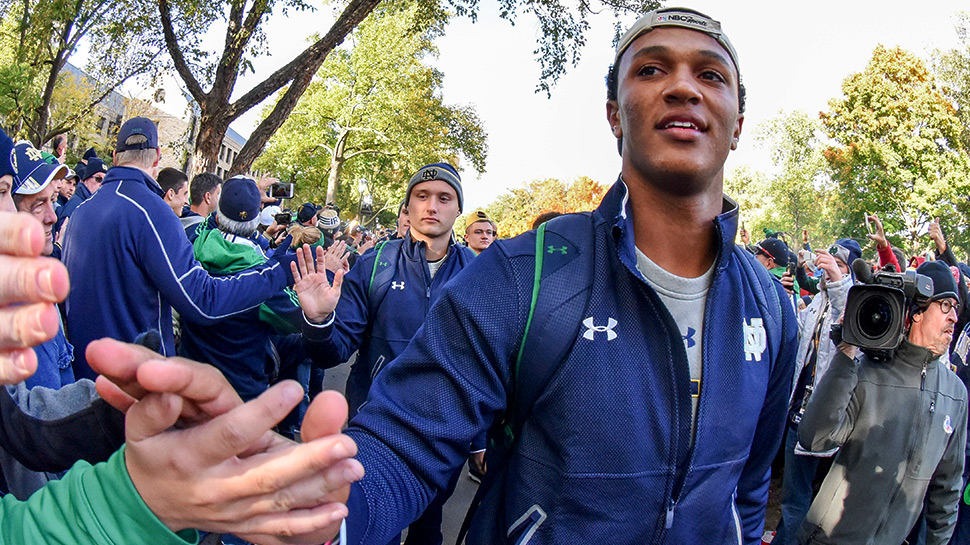 Playing the role of quarterback at Notre Dame may be a stressful assignment in the eyes of some, but Kizer allows no grass to grow under his feet. Despite his newfound celebrity status, he’s enjoying every minute of his campus experience. After all, this is exactly why he came to Notre Dame.Photo by Mike Bennett, Lighthouse Imaging
Playing the role of quarterback at Notre Dame may be a stressful assignment in the eyes of some, but Kizer allows no grass to grow under his feet. Despite his newfound celebrity status, he’s enjoying every minute of his campus experience. After all, this is exactly why he came to Notre Dame.Photo by Mike Bennett, Lighthouse Imaging
As recently as May, Kizer listed third on the Notre Dame depth chart at quarterback. He was projected as the Irish holder on field goals and PATs-and that might well have ended up being his most noteworthy accomplishment in 2015.
Then Everett Golson opted to transfer to Florida State.
Then Malik Zaire broke his ankle Sept. 14 in Notre Dame’s second game of the season at Virginia.
A week later, in Notre Dame Stadium against a dangerous Georgia Tech team, Kizer started his first game as the Irish signal caller.
In a season that began with a brutal series of injuries to frontline Notre Dame personnel, Kizer has joined running back C.J. Prosise (who has filled in for the injured Tarean Folston) and others in exemplifying Irish head coach Brian Kelly’s “next man in” philosophy.
The Irish stand 10-2 and Kizer’s play has proved to be a big reason his team remained in the College Football Playoff conversation through the end of the regular season.
This is the backstory of Kizer’s rise from a talented but raw athlete from Toledo, Ohio, to the occupant of one of the most visible and scrutinized positions in all of college football.
 “He knows how to find people and determine where people are supposed to be and make it work for him. In basketball at point guard he knew where everybody was supposed to be. He likes being in charge. He wants to know how everything works. He knows if he puts his all into it there’s a greater sum at the end.” Derek Kizer, DeShone’s fatherPhoto Scott Grau
“He knows how to find people and determine where people are supposed to be and make it work for him. In basketball at point guard he knew where everybody was supposed to be. He likes being in charge. He wants to know how everything works. He knows if he puts his all into it there’s a greater sum at the end.” Derek Kizer, DeShone’s fatherPhoto Scott Grau
Kizer grew up in a sports-familiar household in Toledo, with his father Derek having played college basketball at Bowling Green and mother Mindy a talent in volleyball.
“We always thought it would be basketball for DeShone,” says Mindy. “Derek coached him in fourth grade in basketball, then he played in a lightweight football league in fifth grade.
“In seventh grade he moved to a more aggressive league with a higher weight limit. He stepped in that year at quarterback when an eighth-grader was injured and we knew then DeShone had a chance to maybe be special.
“One of the coaches had all these CDs and videos, and they would watch them over and over again to teach him how to get better. So it was all self taught.”
Derek echoes his wife’s sentiments:
“We knew he was a very talented athlete. I pushed him toward basketball, and he played football with his friends.
“It was in the seventh grade, he was playing Mid City football. One of my buddies who played high school and college football, coached a little football and played a little semipro football, said, ‘I don’t know if you know how good he is – he has everything to be a big-time quarterback.’
“I said, ‘Why do you say that?’
“He said, ‘He plays on a team with an offensive line that’s horrible, but he still throws the football. He’s the only kid I’ve seen who will stand in the pocket, find a receiver with a defensive lineman barreling down on him, take some of the most brutal hits, still get the ball out there and pop right back up and see if his receiver caught the ball. You don’t get that with 13-year-old kids.’
“He said, ‘Your son is going to be special.’
“I said, ‘Maybe.'”
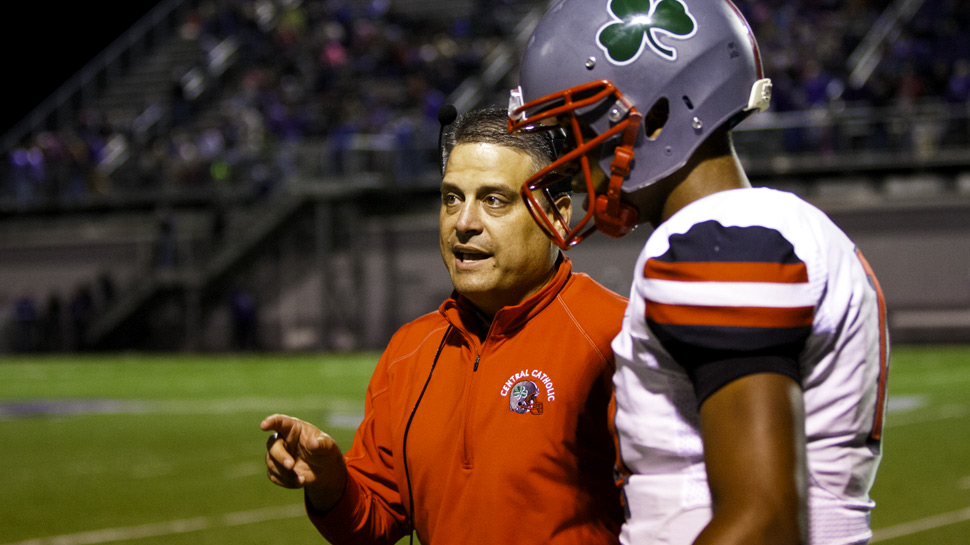 “Once he came up to varsity and started practicing with us, you knew you were going to be able to do some things with him. His game got better every game, every season, every situation he faced. ” — Greg Dempsey, Head Coach, Central Catholic FootballPhoto Scott Grau
“Once he came up to varsity and started practicing with us, you knew you were going to be able to do some things with him. His game got better every game, every season, every situation he faced. ” — Greg Dempsey, Head Coach, Central Catholic FootballPhoto Scott Grau
Greg Dempsey has been the ultra-successful head football coach at Toledo Central Catholic High School since 2000. Jim Welling coached basketball at Central Catholic for six seasons before retiring in 2014 (maybe not by accident after DeShone Kizer used up his eligibility). Welling remains the director of admissions at Central Catholic. The pair watched Kizer grow up and flourish in their respective sports.
Dempsey and Welling remember Kizer being anything but a secret as a Toledo public school junior high schooler.
“Without a doubt, DeShone as an eighth-grader had exceptional gifts,” says Welling. “Any high school in town would have loved to have him. I’ve actually known the Kizer family for a long time. When I was head (basketball) coach at Owens Community College, DeShone’s father Derek and his brother Aundre used to come to play all the time at our open gyms. DeShone’s gotten his foundation from having two parents who know how to keep him grounded.”
Dempsey has a similar take:
“You know about him coming in as a freshman because he came to our camps when he was in junior high. He was known to everybody around town. You were just hoping you were his choice.
“At camp in junior high he took learning the game and learning the quarterback position very seriously–and you don’t see that in kids that age. He came to get better and learn and you could tell that.”
Mindy says there was no question where her son was bound: “He fell in love with Central Catholic and Coach Dempsey. He was going there hands down.”
Dempsey was happy to have him.
“Everybody talked about him playing three sports, but to me there was no question his sport was going to be football.” Dempsey adds. “He was going to be able to do things at a level in football that he wouldn’t in the other sports – I thought that was obvious. But whatever season he was in, that’s what he focused on. When it came to throwing the football around after our season ended, I’d just say, ‘See you in the summer, DeShone.’
“He didn’t have a personalized quarterback coach. As he got older and colleges came into the picture, it was just getting out and doing it himself. He’s a self-driven young man.
The Central Catholic coach quickly realized Kizer could open some doors for his team.
“He played freshman ball as a freshman, and some of my assistants to this day can’t believe I didn’t bring him up (to the varsity team) as a freshman. I just thought that was too big a culture shock to go from junior high to varsity football on a team that was expected to do pretty well. Once he came up to varsity and started practicing with us, you knew you were going to be able to do some things with him. His game got better every game, every season, every situation he faced.
“His first four games of his freshman year were very slow in terms of production and then it just clicked. You started seeing some things that made you stop and think, ‘We’ve never had this before.'”
And the results proved impressive: Three years as a starter produced a 34-6 record, a 2012 Ohio Division II state crown for Central Catholic and Associated Press Ohio Division III co-offensive player of the year honors as a senior in 2013.
Toledo isn’t necessarily known as a huge Notre Dame football town. The biggest Irish names from there include Dick Szymanski, Andy Huff, Dan Harshman and Central Catholic product and tight end Dean Masztak.
“Being from Toledo you’re either Ohio State or Michigan and you don’t like Notre Dame,” explains Derek. “I have a lot of big Buckeye friends, and so now they’ll watch DeShone and then flip to check the Ohio State score. I think he’s had an effect on the area, so it’s been fun. We haven’t really had a major kid from Toledo in a long time.”
Notre Dame quarterbacks from Toledo? The list is Eddie Scharer (backup to Four Horseman Harry Stuhldreher in 1924 and then in 1925) and 1917-18 reserve Frank (Abbie) Lockard.
(On a technical basis, the best quarterback to come out of Toledo to date may well be Jim Harbaugh, the current University of Michigan head football coach who was born in Toledo when his father Jack was a coach at Perrysburg High School, southwest of Toledo–but Jim played his high school ball in California and Michigan.)
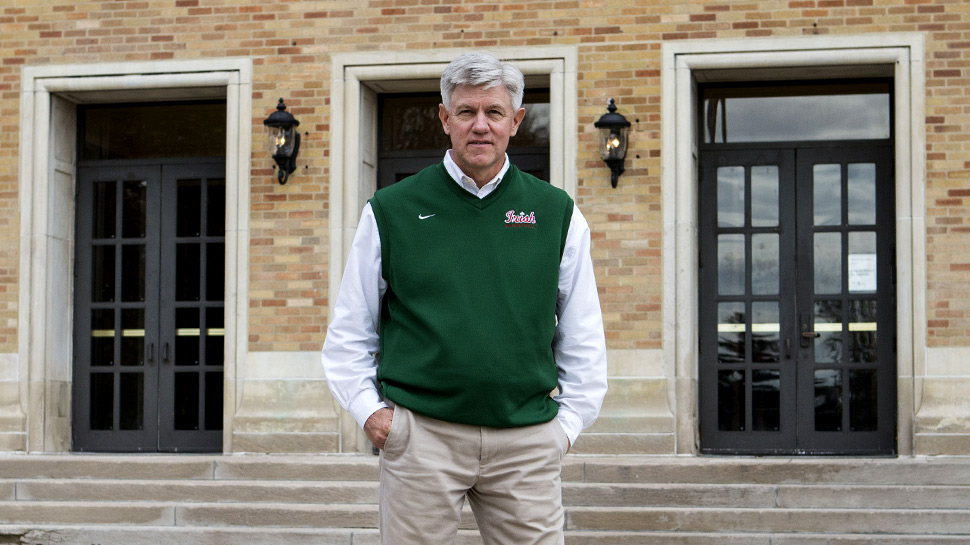 “Right when DeShone’s senior year started, I get a phone call and it’s Coach (Brian) Kelly on the phone. I thought maybe it was a prank, but it’s the Coach Kelly. He says, ‘Is DeShone there, I need to talk to him right away.’ He wanted to make sure DeShone was enrolled in physics the fall of his senior year. They cared more about him as a student first. That’s what it’s supposed to be all about.” — Jim Welling, Director of Admissions, Central Catholic High SchoolPhoto Scott Grau
“Right when DeShone’s senior year started, I get a phone call and it’s Coach (Brian) Kelly on the phone. I thought maybe it was a prank, but it’s the Coach Kelly. He says, ‘Is DeShone there, I need to talk to him right away.’ He wanted to make sure DeShone was enrolled in physics the fall of his senior year. They cared more about him as a student first. That’s what it’s supposed to be all about.” — Jim Welling, Director of Admissions, Central Catholic High SchoolPhoto Scott Grau
Welling admits his bias, yet he remains convinced Kizer could have become a big-time basketball talent.
“He comes in here and they were undefeated on the freshman football team-he didn’t play varsity his first year,” says Welling. “Then he transitioned into basketball and we had tryouts and DeShone was so gifted he made the varsity as a freshman. That doesn’t happen every day. He had such God-given ability.”
Welling still refers to Kizer as the high school version of Magic Johnson.
“That’s how good he was,” he says. “If you were the open guy he would put a dime right there for you to get a shot. He was a tremendously gifted young man. I can’t tell you how many four-year college coaches came in-football coaches watching DeShone at basketball practices. There were probably two dozen.
“The things he had most kids only wish they had. He’s the first kid in my 35-year coaching career to play for me for four years. The only one ever. He got third team all-state Division I basketball averaging 11 points a game-that’s how much respect he had from the community and the state of Ohio.
Welling remains convinced Kizer could have developed into a major-college basketball standout:
“I told DeShone, ‘I don’t know what sport you’re going to be the best at – but you are a guaranteed mid-major basketball player if that’s what you want to do.’ And remember he’s really part time in everything because of the seasons. There was no time to work on your game like these kids do now because it was on to the next sport. If he had worked on his game in basketball for 11 or 12 months and played AAU, he probably could have been a Big Ten or BIG EAST player.
“How many 6-5, 220-pound point guards do you find? He was team captain his junior and senior year, he’s the all-time assist leader in the history of the school. He started at point guard as a freshman on a team that went to the final four of the Ohio state tournament. He played in front of 13,000 people. He learned a lot and grew a lot.”
Welling remembers being particularly impressed with Kizer’s reaction to an injury.
“His sophomore year in the sectional finals we’re playing Bowsher and he sprained his ankle in the first or second quarter. We won the game handily, but he was out the rest of the game and probably had a pretty severe grade sprain. We iced it and got him treatments to get the swelling down for the district semis.
“That to me was the best thing I’ve ever seen DeShone do. His toughness and his drive to get back out there – he wasn’t going to be denied the chance to get back on the floor because he thought our team had a chance to go deep into the tournament. We lost, but that grittiness and toughness was the first time I saw that out of him.
“I used to kid him-if you’d spend as much time as you do concentrating on your no-look passes and apply some of that on the defensive end–now we’ve got something really special. His senior year he was as good defensively as anybody we had–he could lock anybody down when he put his mind to it.”
 “”He has so many people who loved him even before he did anything at Notre Dame. He’s got all these people praying for him and it’s because he’s so humble.” — Mona McGhee, College Counselor, Central Catholic High SchoolPhoto Scott Grau
“”He has so many people who loved him even before he did anything at Notre Dame. He’s got all these people praying for him and it’s because he’s so humble.” — Mona McGhee, College Counselor, Central Catholic High SchoolPhoto Scott Grau
Mona McGhee is the college counselor at Central Catholic, in her 40th year at the school. She recalls another basketball game that showed her what DeShone was all about:
“His leadership was off the charts. He ran that team like he was the general and we’re all going to win together. We were playing Whitmer High School, a big rival for us, and they had Nigel Hayes (a 6-7 standout who was third-team all-conference in 2015 at Wisconsin) who took the Big Ten by storm.
“DeShone got it in his head, ‘Not tonight, Nigel.’ He matched him point for point and DeShone must have hit six or seven three-pointers. Everyone’s mouth just dropped. He was on fire. It went into overtime with a team we probably never should have gotten it into overtime. We ended up losing, but when I see what Nigel Hayes has done, I think about how when DeShone sets his mind to something, this is how it’s going to work.”
McGhee worked with the Kizer family when DeShone was making his high school choice. She remembers DeShone as an eighth-grader, approaching her at a Central Catholic football game.
“DeShone comes and sits down with me and we have the most amazing conversation. He was smart, intelligent and confident. DeShone, to me, will always be that eighth-grader being gracious and asking those important questions about his future. I don’t think many eighth-graders are gracious.
“Once he came to Central Catholic, we had a great partnership because he was my partner in crime. He had the ability to see a vision that high school kids should not be able to see. If I knew I had a kid in trouble and they needed this or that, I would have a conversation with DeShone. He was the point guard, the quarterback–he was a peer who could get through to a child in a way I could not do. I would sit him down and tell him so and so is struggling because of this in their life-and he’d say, ‘I got it.’ He was the general leading the forces.”
Dempsey also saw a side of Kizer that extended beyond the athletic fields.
“He’s a genuine kid who really cares about other people. I’ve seen him do things for people that no one would ever know – asking someone how they are feeling. During the football pep rally I’ve got to let him get up on stage because he’s part of the school spirit group. He’s not just invested in athletics, he’s very well-rounded with his eyes on his future, including beyond sports. He’s mature beyond his years. He has a great amount of swagger, which I like. He believes in himself. He trusts others and gives credit to others.”
Kizer’s collegiate recruitment began somewhat routinely, with an early offer from Toledo. Bowling Green, Syracuse, Boston College, Illinois and Louisville also showed serious interest. Kizer attended camps at Ohio State and Michigan in the summer of 2012. LSU offered a scholarship in late February 2013, and Alabama followed suit a week later. During high school spring break Kizer made unofficial visits to USC and UCLA.
Recalls McGhee, “Coach Dempsey and I sat with DeShone and his father when they were talking to the Alabama coach via Skype. We were just helping with the technology. Nick Saban was telling them all the things that are a part of the Alabama program. At the end I look at Coach Dempsey and I’m thinking, ‘That’s a hard deal to walk away from.’ We come back and think, ‘How can any kid say no to that when they’re number one in the country?’ But we never said a word to DeShone.”
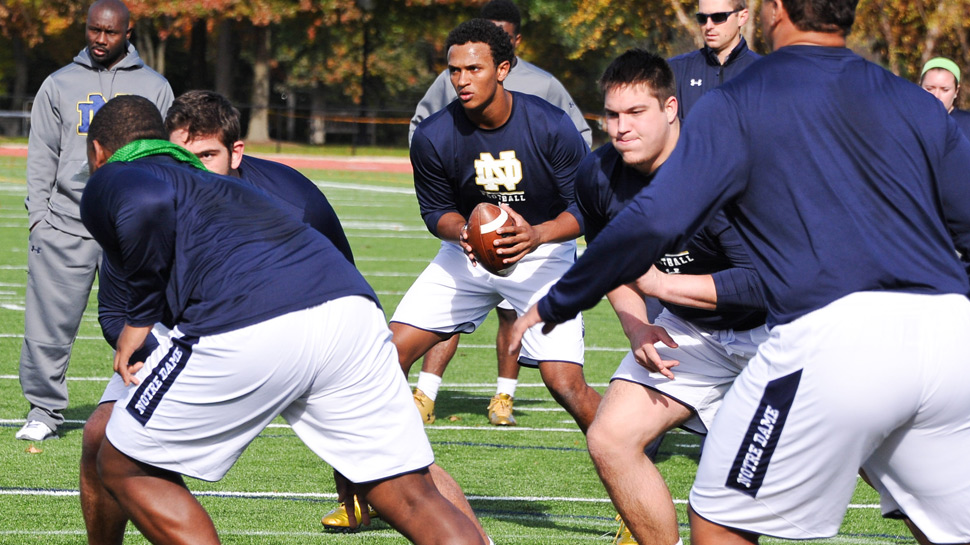 “It’s not just throwing-we were looking for a guy who could handle the pressure and everything else and he had done all that. I knew the type of kid who could thrive at Notre Dame, and Coach Kelly loves competitive kids and with DeShone there were so many positives. So what if he had a bad workout?” — Chuck Martin, former Notre Dame Offensive Coordinator, current Miami (Ohio) Head CoachPhoto Scott Grau
“It’s not just throwing-we were looking for a guy who could handle the pressure and everything else and he had done all that. I knew the type of kid who could thrive at Notre Dame, and Coach Kelly loves competitive kids and with DeShone there were so many positives. So what if he had a bad workout?” — Chuck Martin, former Notre Dame Offensive Coordinator, current Miami (Ohio) Head CoachPhoto Scott Grau
Notre Dame did not originally intend to recruit a quarterback in the freshman class that would enroll in 2013. Heading into that football season, Tommy Rees had a year of eligibility remaining, Golson had two years remaining, Gunner Kiel was heading into his sophomore campaign, and Zaire was an incoming freshman. But before spring drills Kiel announced his plans to transfer-and that prompted a reassessment in the Irish recruiting camp.
Mindy recalls her son stressing about his decision and the process: “DeShone had stayed in contact with the Elite 11 quarterbacks–they would have a group chat on Twitter all the time. Whenever someone pulled the trigger everyone knew.
“He would say, ‘So and so just committed here, so and so just committed there. I’ve got to do it–if I don’t he’s going to jump in there and that spot’s going to go.’ He was afraid he was going to lose out on a big opportunity.
“He had the guts to go in the house and call Notre Dame and convince them to come and look at him again.”
The Irish had decided to reopen their quarterback options, with offensive coordinator Chuck Martin spending the final week of the May evaluation period watching signal-callers. That brought him to Toledo May 22 for an early morning practice on the Central Catholic High School game field. On hand were Martin and Ohio State offensive coordinator Tom Herman (now head coach at Houston).
McGhee loved the way Kizer went about organizing the workout.
“Any other kid I know would be all geeked up because Notre Dame is coming to see him throw. He gets all his text messages lined up with all his receivers. He goes and picks everyone of them up at 5:30 in the morning. He was going to make sure no one was late.
“I looked down at that stadium and I almost had tears in my eyes. This is a kid that knows what he wants and he’s willing to go get it. His receivers were out there killing themselves for this young man.”
Yet, by all accounts, the half-hour throwing session did not go well for Kizer.
“He comes in the office,” says McGhee, “and I don’t say a word to him and he says, ‘I was terrible. It was the worst day of my life.’ I said, ‘Stop being so negative. This is one shot. You’ve done many other things right.’ Meanwhile he’s calling the coaches because he knew when they were boarding and he wanted to say thank you one more time.
“I just figured, if God wants you at Notre Dame, you’ll be at Notre Dame.”
“DeShone knew hands down,” says Mindy “He said, ‘I didn’t throw very well at all and no offers are coming from Notre Dame or Ohio State.’ He’s a mess and he can’t throw the ball right and he thinks it’s over with.”
Martin didn’t look at the workout the same way.
“Between Notre Dame being a place he had an interest in and Ohio State being his instate school, he had some nerves that morning and he did not really throw it very well,” says Martin, now in his second year as head coach at Miami (Ohio).
“There were two schools there he really wanted offers from, it was seven in the morning and he didn’t have his best day.
“I think he thought that was the last he was going to hear from Notre Dame and Ohio State after that morning.
“But we were there for a reason–he was one of the top-rated quarterbacks in the country. For me, I could see he was nervous, it was a big deal for him. I think he might have had a better day if we’d already offered him. He was probably too amped up and too jittery and wanted to do too well.
“It didn’t look the way he played on tape. We’d been recruiting him and evaluating him and we knew his confidence and composure level. He didn’t really show it that morning, but we still believed in him. He’s one of the most confident kids I’ve been around.
“He knew he didn’t do well and I think he thought he’d blown his chance. I’d seen 15 quarterbacks that spring, some of them twice, and I had my short of list of guys I thought could help Notre Dame win. He was one of three on the short list of people we wanted.
“He called me back fairly quickly because he was nervous. I told him, ‘I know you don’t think you did well, but I think I know what you are and who you can become.’
“We were at the end of our evaluation period. I went there with the idea we were going to offer him. It wasn’t great, so we had to rethink what we were doing. But when we reevaluated it all, there were three guys we thought could do it for us and he was one of them. It’s not just throwing-we were looking for a guy who could handle the pressure and everything else and he had done all that. I knew the type of kid who could thrive at Notre Dame, and Coach Kelly loves competitive kids and with DeShone there were so many positives. So what if he had a bad workout?”
Adds Martin, “He’s smart, he’s prepared and he understands the game. Even then you saw all the raw material–he was a big guy with a good throwing motion. He just did not throw it very accurately on that one day.”
Martin and Kelly re-evaluated tape of Kizer-and Kelly ultimately determined a scholarship offer was in order. So with Kizer contemplating those late-winter offers from LSU and Alabama (among others), Notre Dame moved quickly in hopes of dissuading Kizer from visiting those schools. The Irish coaches offered him a scholarship June 5, and four days later Kizer and his parents visited the Notre Dame campus.
On a Sunday afternoon, the Kizers met with Kelly, Martin, then-recruiting coordinator Tony Alford, director of player personnel Dave Peloquin and associate director of student-athlete academic services Adam Sargent. The Kizers toured the campus and Notre Dame Stadium, had dinner at Legends and headed back to Toledo.
“We were awed, just amazed,” says Mindy. “None of us had ever been there (to Notre Dame). You could hear a pin drop in the car on the way home. DeShone said, ‘I think we just made our decision, hands down.'”
Two days later Kizer committed to Notre Dame.
Life didn’t go all that well for Kizer from a football standpoint to start 2015. After watching from the sideline during his freshman campaign in 2014, he faced the same potential assignment while mostly watching Golson and Zaire battle for the starting job during 2015 spring drills in South Bend.
His statistics in the mid-April Blue-Gold final spring game? One rushing attempt for five yards. Five pass attempts, one completion for three yards, one sack. Not much to write home about.
“The frustration was because he couldn’t show that he was a good quarterback,” says Mindy. “He didn’t get a lot of snaps because he was third string. What everybody on campus told him was, ‘The biggest thing is to wait your turn.’ His biggest frustration was, when would his turn come? He wasn’t sure if his time was going to come.
“So he goes over to the baseball batting cages and thinks maybe he should go play baseball. And he rooms with a basketball player (V.J. Beachem). I tell him, ‘Just slow down, this is where you’re meant to be.'”
Kizer’s father tried to add some perspective:
“I told him to take some time and relax,” says Derek. “Kids want that instant gratification. You have to work for this – you just have to continue to work for this – some times you gotta stick things out. Now he tells his younger siblings the same thing: If this is what you want, hang in there and work harder.”
Dempsey noticed his former player’s demeanor.
“When I saw him he’d think out loud a little bit,” says Dempsey. “He was happy with his spring development but not happy with his spring game. He told me, ‘I want to be the starting quarterback at Notre Dame.’
“He knew he had some things to fix, but he was confident in his ability. He knew he could do the job if given the opportunity. Then, when Golson left, now you’re number two and you’re one play away. Unfortunately you don’t want to see people get hurt–but what he has done with that opportunity is pretty special.”
Here’s what else has happened to Kizer in 2015:
The depth chart at quarterback did an about-face a few weeks after spring drills ended when Golson announced plans to transfer after graduation. Kizer was in class at the time of the announcement and his phone immediately “blew up.” Kizer saw his first varsity action in the season opener against Texas, playing the final two offensive series with the Irish on top 38-3. He ran once for nine yards, another time for a yard and threw one incompletion on a third-and-10 play. A week later in Charlottesville, Virginia, Kizer’s life changed dramatically. His first career completion went for a touchdown, on a flip to Durham Smythe on a fake field goal with Kizer serving as the holder. That play put the Irish on top 6-0-and it might have been his season highlight if Zaire had remained healthy. But Zaire broke his right ankle late in the third period. Enter Kizer.
On his first play from scrimmage under center, Kizer handed to Prosise who swept right for a 24-yard TD run that gave the Irish a 26-14 lead. But Virginia came back to take a 27-26 advantage on a score with 1:54 to play. With Notre Dame on the Cavalier 39 and the clock running down below the 20-second mark, Kizer uncorked what turned into a perfectly-lofted throw to Will Fuller who scored the winning points with a dozen ticks on the clock. The Irish won in unlikely fashion 34-27-and the Kizer era was off and running.
“That day was crazy,” says Dempsey. “We got back from football, we’re watching the game and my wife and kids are Notre Dame nuts. Our team had lifted that morning and we had a coaches’ meeting for the following week-so I get home right about kickoff. I know he was not playing and I get a text, ‘Kizer TD pass.’ I thought, ‘Did Zaire get hurt?’ but it was the fake field goal.
“Then he gets thrust into it after Malik does get hurt. I’m watching and my wife is nervous and I said, ‘He’s going to be fine, he loves this stuff.’ I don’t know how it will work out in the end, but he is relishing the opportunity to prove what he can do with the game on the line. He threw that pass and my wife says, ‘You’re not surprised, are you?’ I said, ‘I’ve seen him do that in basketball, I’ve seen him do it in football. Some guys love those moments and that’s who you want taking those shots.’ With us he didn’t always have it go his way in those moments, but he always bounced back. He has that resiliency you need to be a quarterback.”
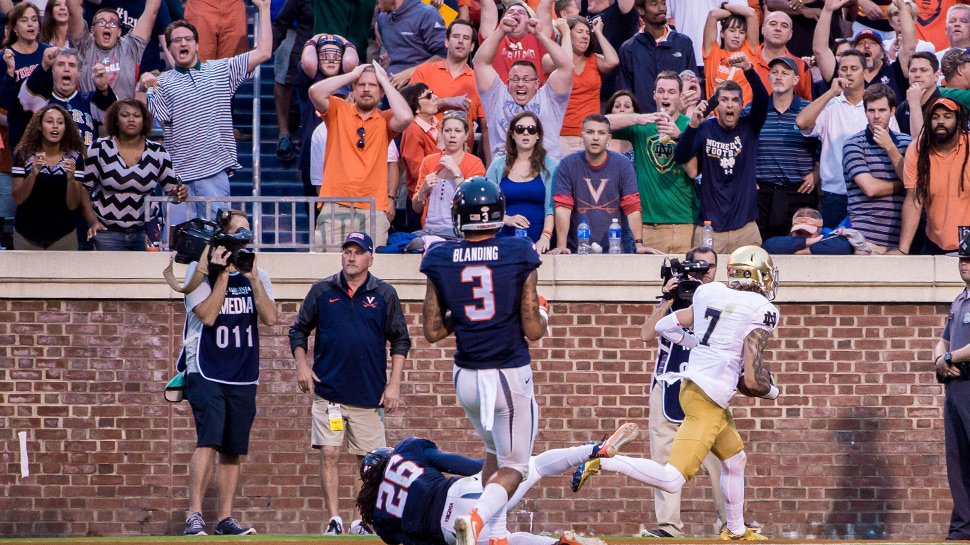 “He threw that pass and my wife says, ‘You’re not surprised, are you?’ I said, ‘I’ve seen him do that in basketball, I’ve seen him do it in football. Some guys love those moments and that’s who you want taking those shots.” — Greg Dempsey, Head Coach, Central Catholic FootballPhoto by Mike Bennett, Lighthouse Imaging
“He threw that pass and my wife says, ‘You’re not surprised, are you?’ I said, ‘I’ve seen him do that in basketball, I’ve seen him do it in football. Some guys love those moments and that’s who you want taking those shots.” — Greg Dempsey, Head Coach, Central Catholic FootballPhoto by Mike Bennett, Lighthouse Imaging
Says Irish quarterback coach Mike Sanford, “The biggest thing we saw instantly? He could play with the game on the line. We did not know that. We had no idea what it was going to be like when the live bullets are flying and your backs are against the wall and you’ve got to go out and perform at a high level. That became a strength of his immediately.”
Kizer found himself in the middle of an awkward postgame locker room scene. In other circumstances, Kizer would have been celebrating the last-second triumph. But that seemed inappropriate when Zaire, in the locker right next to his, was in tears, with his season lost. The two shared significant words and hugs-with neither sure exactly what the road ahead would bring.
Maybe most impressive was Kizer’s performance in the postgame interview room in the bowels of Virginia’s stadium. The sophomore handled every query with aplomb, as if he’d been doing it for years. He could have been running for president based on his comfort level that day. More than anything, it sent a message to anyone connected with the Irish program that the moment wasn’t going to be too big for Kizer.
In his first start a week later at Notre Dame Stadium against 16th-ranked Georgia Tech, Kizer completed an efficient 21 of 30 passes for 242 yards and two scores in the impressive Irish win. The first Notre Dame points came on a 46-yard Kizer TD pass to Fuller. After a slow start by all the Irish at Clemson, Kizer came on late, throwing for 202 yards in the final period alone. He finished with a career-high 321 passing yards, but the Notre Dame effort barely missed when a two-point conversion run by Kizer came up short in the final seconds. When the Irish fell behind early in the second half versus USC, Kizer led the Irish on scoring marches of 90 and 91 yards and Notre Dame won 41-31. Kizer connected early with Fuller for 75 yards and late with Corey Robinson for 10 yards and the last Irish TD.
Kelly’s assessment that night on how Kizer went about his business: “North of confident, south of cocky.” And he absolutely meant it as a compliment.
“I knew he was a confident kid,” says Notre Dame’s head coach. “But he carries it all the time, and people on this football team respect him because of it.”
When 21st-rated Temple took a 20-17 lead with 4:45 remaining, Kizer led an impressive 75-yard, six-play scoring drive that ended with a 17-yard TD pass to Fuller. Just as noteworthy was Kizer’s 79-yard sprint down the Irish sideline for a first-half score.
Says Mindy, “He’s a true pocket quarterback, but he can extend a play if he needs to. He made a point to show people he could run the ball because the perception was that he couldn’t do it. He has long strides.
“After the long touchdown run at Temple, I got 20 texts from family members . . . ‘Where did this come from? This boy can run.’
“And I was in the restroom on that play.”
A week later in Pittsburgh, Kizer threw five TD passes (three to Fuller), connecting on 19 of 26 throws. He ran for a sixth score, meaning he accounted for 36 points-and the Notre Dame record, set in 1911 by Art Smith, is 37.
“We’re clearly impressed with what he’s been able to accomplish in this period of time,” said Kelly the next week.
Despite a trio of interceptions at Fenway Park against Boston College, Kizer completed 20 or more passes for the fourth time in 2015, this time for 320 yards.
In the regular season finale at 13th-ranked Stanford, Kizer threw for 234 yards, ran for another 128 and scored from the two-yard line with 30 seconds left for the apparent game-winning points-only to see the Cardinal kick a field goal as time expired to win. Said Kelly after the game, “He’s still learning, but the moment is never too big for him. Who wouldn’t want that guy back next year?”
At the end of Notre Dame’s regular season, Kizer ranked 20th nationally in passing yards per attempt (8.72 yards each), 23rd in passing efficiency (151.7 rating points) and 34th in completion percentage (.634). He has completed 189 of his 298 passes for 2,600 yards with 19 TDs and only nine interceptions. He has rushed 119 times for 499 yards (third on the team) and nine TDs (tying the Irish season record for quarterbacks).
With a bowl game to play, DeShone Kizer ranks in Notre Dame single-season charts: fourth in completion percentage, fifth in passing efficiency, sixth in total offense (258.3), seventh in TD passes, eighth in passing yards and 10th in passing yards per game (216.7).
Without question, Kizer has benefitted from the versatility of a talented Notre Dame offensive unit. He can hand it to Prosise or Josh Adams-or throw it to a solid contingent of receivers led by Fuller and veteran Chris Brown, all the while working behind an experienced offensive line led by Ronnie Stanley and Nick Martin.
Yet the 6-4 ½, 230-pound Kizer has proven more than capable of making plays when they need to be made. And he’s a leader of a Notre Dame offensive that ranks among the most productive in Irish history in terms of points (34.8) and total yards (471.5).
Adds Mindy, “One coach from a big Division I program was having a talk with us during the recruiting process and he says, ‘So, Mrs. Kizer, did you think you’d be sitting in your living room talking to . . . ‘ and he used his name. I said, ‘Absolutely. This is what DeShone worked hard for.’
“The coach was floored by that. But this is exactly what we thought would happen. Did we think it would happen how it happened? No way. That’s why he’s always prepared for this. He’s the epitome of the next man in. This is what we groomed him for.”
Dempsey is convinced his former pupil is in a good place in South Bend:
“I’ve seen Coach Kelly a lot between Grand Valley and Central Michigan and Cincinnati-he’s always taken a variety of quarterbacks and they always seem to be successful and win. You see quarterbacks these days that specialize and have the quarterback coach. DeShone had none of that, so that meant his room for improvement is greater than with most people. It’s focusing just on football for the first time and being around other great players and players who can make you better.
“Chuck Martin believed in him and convinced him he could do it. Matt LaFleur (the 2014 Irish quarterback coach) showed him things he needed to get done. Coach Sanford knows the science of the position. So DeShone has taken things from Coach Kelly and all those guys that are invaluable.”
Welling is even convinced DeShone had a football future in something other than quarterbacking:
“I used to kid DeShone that he ought to go into Coach Kelly’s office and tell him he wanted to be a punter.
“Have you ever seen DeShone punt? It’s ridiculous. Our basketball team would be conditioning outside in the fall and he’d be on the football field in pre-practice, taking snaps for punting. It’s like NFL style-50– and 60-yarders with great hang time. I would go, ‘Are you serious?’ He’d just roll his eyes.
“But he has gifts we could only wish most kids have. His God-given abilities are as good as anybody I’ve coached or been around.”
Adds McGhee: “Most of the time he has more confidence in his little finger than most kids have in a lifetime.”
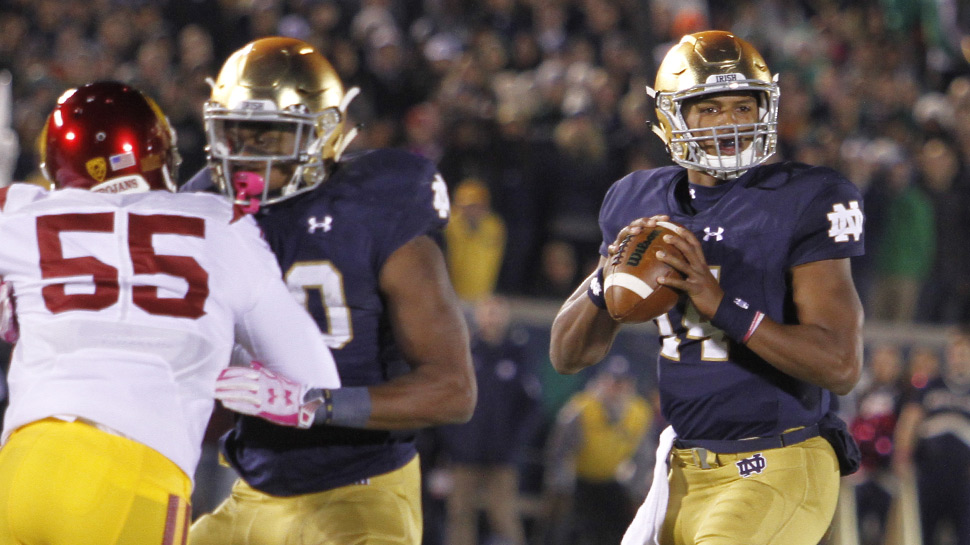 “…he has more confidence in his little finger than most kids have in a lifetime.” Mona McGhee, College Counselor, Central Catholic High SchoolPhoto by Matt Cashore, University of Notre Dame
“…he has more confidence in his little finger than most kids have in a lifetime.” Mona McGhee, College Counselor, Central Catholic High SchoolPhoto by Matt Cashore, University of Notre Dame
Life is different these days for all the Kizers. If DeShone previously survived in semi-anonymity, much of his extra time is taken up by media requests and more football meetings, including a couple per week with Kelly.
“It’s time management – just not enough hours in the day,” says Mindy.
And the challenges extend to others in the Kizer family.
“I’m a bailiff in the family court building downtown–we do divorces and domestic violence,” says Mindy. “I started here when DeShone turned one, so there are a lot of people here who have watched DeShone grow up. We have the 5-10-minute conversation about DeShone, and then we get down to business.
“I walk through the grocery store and someone I don’t know will stop me and say, ‘We’re not Notre Dame fans, but we watch your kid play every week.’ I don’t know who all these people are and they stop and say I know your son. That’s craziness.”
If there are two people who are comparatively unimpressed (and keep DeShone grounded), it’s DeShone’s 15-year-old sister Maelyn (she’s a high school freshman) and 13-year-old brother Dayven (he’s a seventh-grader).
“It’s no big deal to them,” says Mindy. “I want them to know how big it is and they say, ‘Yes, Mom. we know.’ It’s been a gradual uphill thing like this since he got to high school–going to state in basketball as a freshman, then winning the state title in football. So they think this is just the next step.”
Walk into the main office at Central Catholic, and there are two newspaper articles about Kizer taped to the counter. One is a USA Today piece from September with a headline reading, “Notre Dame Puts Playoff Trust in Hands of Kizer.”
“I can’t imagine what’s it’s been like for him and his family because I know what it’s been like for our school. It’s been crazy,” says Dempsey.
“The national magnitude that Notre Dame brings, and then him being the quarterback at Notre Dame brings even more to it.
“Lots of buzz around here – a lot of new Notre Dame fans – people are very proud, especially the way he carries himself. It’s good to see how many people are rooting for him. You have to be confident in that position. On the field ability is just one piece of the pie to be the quarterback at Notre Dame.”
Welling loves the way DeShone, a business major in the classroom, has learned to see the big picture:
“The thing we’re most proud of is the way he developed into a person who can make a difference in other young people’s lives.
“He’s got a great story to tell. He can be a great role model for a whole bunch of kids, not just in Toledo.”
Others around Kizer say he’s the same person, even after all the events of the last few months.
Irish quarterback Montgomery VanGorder has a locker next to Kizer in the Gug and rooms with him on Friday nights before games.
“He really hasn’t changed much,” says VanGorder. “He’s a lot busier and a little more reserved, his time is taken up now. He likes to hang out with us and play ping pong. That’s his chance to relax.
“He’s very into his style–he has to always look good. He has his own little swag.”
Rob Hyland, producer of the Irish home football games on NBC, has a chance to meet with Kizer every Friday before telecasts.
“I’ve been so impressed by DeShone in our interactions,” says Hyland. “To think he’s only in his second year here at Notre Dame is mind-boggling. He seems like an adult, a grown man with a perspective on being a student at Notre Dame and the quarterback at Notre Dame that goes well beyond his years.”
Former Irish All-America cornerback Todd Lyght is now Notre Dame’s first-year defensive back coach. His charges line up against Kizer in some form almost every day in practice.
“It’s his demeanor and consistency no matter what’s going on, whether he’s playing well or dealing with some adversity. He almost seems to play better after he’s made a mistake,” says Lyght.
“It’s uncanny for a player his age. I really like that about him.”
Maybe no one has a better sense of what Kizer’s life is all about than current Irish director of player development and former Notre Dame quarterback Ron Powlus.
“I’ve talked to him about how you’ve always got to be on,” Powlus says. “In my experience, even coming in heralded to becoming the starting quarterback–it’s still a big step. I always said back then, it’s not me, it’s the position I’m in. I think he kind of sees it the same way. But I think he’s got his stuff together pretty good.”
What everyone likes is that, even with all of Kizer’s success, all involved appreciate that he remains a work in progress.
Says Sanford, “What we saw was the amount of growth that needed to happen from a consistency standpoint with fundamentals. The thing that we’ve been so impressed with is how quickly he can make corrections and improvements. You see things change week to week, and it’s more of a credit to him than anyone. You can coach guys and say the same thing over and over, but it never gets changed because they have habits. DeShone will work on his flaws and it shows up on Saturday.
“I love that – he’s not a finished product – you get a chance to form some positive habits. Our standard for him grows every week, but it’s clear in his mind and our mind and when you watch the film that his room for improvement is still so significant. And that’s exciting for all of us.”
Welling appreciates the local pride in their former pupil:
“We can’t wait to watch Notre Dame football because of him.”
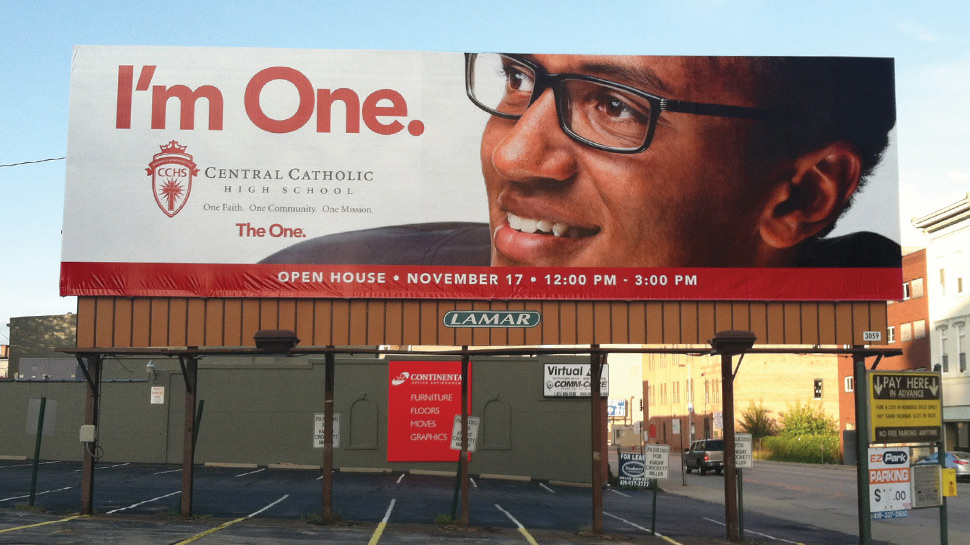 Back in his hometown, Kizer already has reached larger-than-life statusPhoto by Mike Bennett, Lighthouse Imaging
Back in his hometown, Kizer already has reached larger-than-life statusPhoto by Mike Bennett, Lighthouse Imaging
The DeShone Kizer story has just started to unfold. After all, he could be the starting quarterback at Notre Dame through the 2018 season.
But, back in his hometown, Kizer already has reached larger-than-life status.
There’s a large horizontal banner in the main Central Catholic hallway featuring a huge close-up image of Kizer.
That sign is part of a Central Catholic marketing campaign highlighting a handful of high-achieving current and former Central Catholic students.
When Kizer was still a Central Catholic student, another image of him-showing him from the rear, holding a football with his left hand while wearing his No. 14 jersey-was utilized in a similar fashion. One of those Kizer banners was displayed on the side of the 10-story downtown Spitzer Building for a year.
The ongoing title of the promotional campaign is “The One.” The theme refers to Central Catholic’s tagline–One Faith. One Community. One Mission.
If Kizer’s play with the Irish keeps at its current elevated pace, that title may well take on a double meaning before long.







